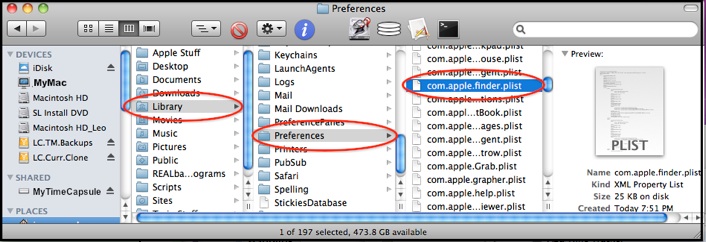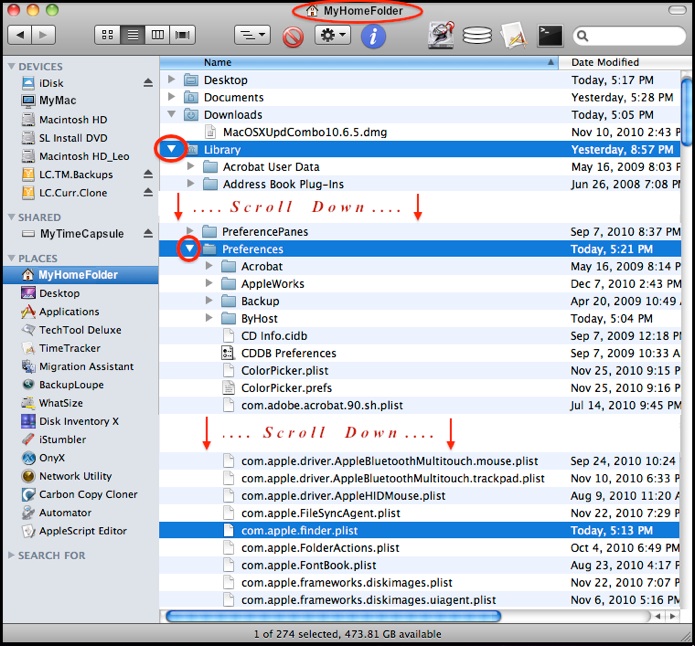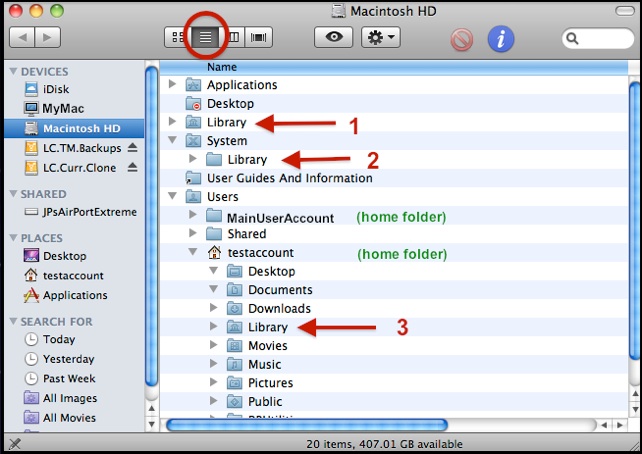Time Machine - Troubleshooting
A7. How to Navigate to a file
Time Machine - Troubleshooting
A7. How to Navigate to a file
Sometimes you can’t find a file by searching in Spotlight or via a Finder Search. But if you’ve been given a file path, something like this: ~/Library/Preferences/com.apple.finder.plist,
OSX considers many such files as system files, so they may not appear in a search.
To use a file path, you need to know how to read them. We’ll use a common sample, the various Library folders on your Mac's internal HD, usually named Macintosh HD, per the sample.
If your internal HD (usually named "Macintosh HD") isn't shown in the Finder sidebar, go to Finder > Preferences > Sidebar and be sure there's a check mark (not a dash) in the Hard disks box in the DEVICES section.
A slash before a name means "at the top level of your Startup volume (internal HD)." So the
/Library folder is at the top of your HD. Some posters specify it this way: HD/Library (#1 below).
Each slash indicates an included folder, so /System/Library means the Library folder inside the
/System folder that’s at the top level of your Startup volume (#2 below). But you should never touch that folder.
Then there’s your Home Folder, containing many files and folders for your user account. Each Mac has at least one of these; each user account has a separate one. It’s the folder with the little house icon in a Finder Sidebar. Sometimes this is specified as ~/Library while others will show it as <home folder>/Library (#3 below).
ICON view
LIST view
This indicates the Finder window in List View being scrolled:
COLUMN view



however, the ~/Library folder is hidden by default.
The easiest way to get to it is to hold the Alt/Option key while selecting Go in the menubar, then select it from the drop-down menu:
Or press Shift+Cmd+G and type /Library in the prompt.
You can make it permanently visible by starting the Terminal app (in your Applications/Utilities folder), and copying and pasting this after the prompt:
chflags nohidden ~/Library then pressing Return.
To navigate, you use a Finder window. Just how you do it depends on the style you like: Icon View, List View, or Column View. You can change the View style by clicking View in the Menubar, then the one you want, or by clicking the icons in the toolbar (if there are no icons, select View > Customize Toolbar from the menubar).
Select the appropriate starting point in the sidebar, then just continue through the list of folders in the path, locating and clicking each file (or disclosure triangle) in turn, until you get where you want.
For the sample of ~/Library/Preferences/com.apple.finder.plist, that’s in your home folder.
The results will look a bit different for each view (selected via the View item in the menubar):
A Finder window (in List view) showing the internal HD looks something like this:
The Desktop folder on the second line is not a user's desktop folder (there's one of those inside each user home folder). It's a system folder that normal users don't have permission to.
1 /Library is a mix -- it contains some system-type things, including printer drivers, plus some system-wide settings and preferences, such as your system configuration, power, network, and Time Machine settings.
2 /System/Library is OSX's main system folder (most of the others are hidden).
3 ~/Library contains things for each user account, such as preferences and data. That's how your Mac can have different email accounts, iPhoto libraries, etc., and application settings and preferences for each user. On Lion and later, these are hidden by default. See the tan box below.
Never change things in these folders unless you're certain what you're doing -- and even if you are, be very careful -- all sorts of bad things can happen!
